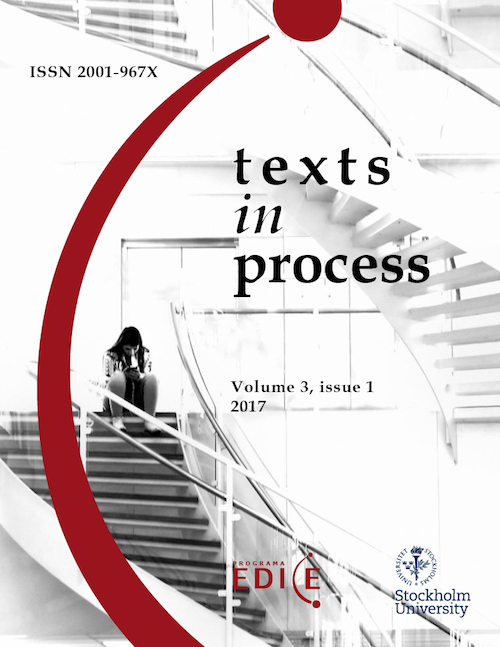Origin of the pronominal diversity in America
Peninsular influences or diastratic and diaphasic factors?
Abstract
Through letters from individuals to Indies (16th century), and according to three sociolinguistic criteria (gender, diaphasia, diastratia), I have analysed the Spanish pronominal system evolution in a variety of forms of treatment and sentence constructions, as well as considering the morph syntactic aspects (evolution of tenses) in the letters’ discourses. The results of this quantitative and qualitative analysis corroborate the evolution of different pronouns that went to America (vuestra merced, vos, vosotros and tú); the evolution depends both on socio-cultural issues and register, since context, for example, in the case of vosotros and vuestra merced, appearing on complaints and pleas. In addition, independently to the verbal pronominal system, I have explored the cause why these forms are not a single block. Thus, we see a high degree of diphthongization (-ais, -eis), which testifies the expansion of diphthongization in the 16th century Spanish. As for the forms, which are not diphthongized, its appearance is minimal and reduced to forms stressed on the third-to-last syllable, against those, which are penultimate stressed syllable forms. There is also in this period an initial phenomenon of overcorrection (vinieredeis; trajeredeis), indicating both the loss of -d- and its stigmatization. Although our corpus do not constitute a pure sample of oral language of the 16th century, these written letters may be considered similar to hearing samples.
Downloads
References
Boyd-Bowman, P. (1964), Índice geobiográfico de 40.000 pobladores españoles de América en el siglo XVI. 1493-1519, Bogotá: ICC, vol. II.
Calderón Campos, M. (2010), “Formas de tratamiento”, en: M. Aleza Izquierdo y J. M. Enguita Utrilla (coords.) La lengua española en América: normas y usos actuales (pp. 225-236), Valencia: Universitat de València.
Cano Aguilar, R. (1996), “Lenguaje ‘espontáneo’ y retórica epistolar en cartas de emigrantes españoles a Indias”, en: T. Kotshchi, W. Oesterreicher y K. Zimmerman (eds.) El español hablado y la cultura oral en España e Hispanoamérica (pp. 375-404), Sevilla: Universidad de Sevilla.
Fernández Alcaide, M. (2009), Cartas de particulares en Indias del siglo XVI, Madrid: Iberoamericana.
Iglesias Recuero, S. (2008), “Aportaciones al origen de (la) Vuestra Merced como forma de tratamiento”, en: C. Company Company y J. G. Moreno de Alba (eds.) Actas del VII Congreso Internacional de Historia de la lengua española (vol II, pp. 1869-1884), Madrid: Arco/Libros.
Lapesa, R. (1970), “Personas gramaticales y tratamientos en español”, Revista de la Universidad de Murcia, XIX, IV, pp. 167-193.
Lapesa, R. (1992), “El español llevado a América”, en: C. Hernández (ed.) Historia y presente del español de América (pp. 11-24), Valladolid: Junta de Castilla y León, Pabecal.
Laviana Cuentos, Mª L. (1996), La América española, 1492-1898. De las Indias a Nuestra América, Vol. XIV, Historia de España, Madrid: Historia 16.
Lope Blanch, J. M. (1989), Estudios de Lingüística Hispanoamericana, México D.F.: UNAM.
López Serena, A. (2011), “Más allá de los marcadores del discurso”, en: J. J. de Bustos Tovar, R. Cano Aguilar, E. Méndez García de Paredes, A. López Serena (eds.) Sintaxis y análisis del discurso hablado en español. Homenaje a Antonio Narbona (275-294, Vol. I), Sevilla: Universidad de Sevilla.
Rona, J. P. (1967), Geografía y morfología del voseo, Porto Alegre: Pontificia Universidade Católica do Rio Grande do Sul.
Sáez Rivera, D. (2003), “Vuestra Merced > usted: nuevos datos y perspectivas” en: J. J. De Bustos Tovar, J. L. Girón Alconchel (eds.) Actas del VI Congreso Internacional de Historia de la Lengua española (pp. 2899-2913, Vol. III), Madrid: Arco/Libros.

Copyright (c) 2017 Paula Albitre Lamata

This work is licensed under a Creative Commons Attribution 4.0 International License.
Texts in Process (TEP) is a non-commercial open-access scholarly journal governed by a Creative Commons Recognition 4.0 International license. It follows a full and unrestricted open access, without charges or fees for shipping, reviewing, processing and publishing articles. Users can read, download without registering, distribute, print or link the complete texts of numbers and articles, without the permission of the editors or authors. There is also no charge to publish (APCs), being applicable to the entire editorial process. The authors retain their intellectual rights at all times.
ASICE-EDICE Programme has always believed that non-commercial, open, unlimited and unrestricted access to specialized academic publications is a vehicle for academic freedom and scientific rigor. It adheres and shares the Declaration of Mexico and DORA to guarantee the protection of academic and scientific production in Open Access.
















